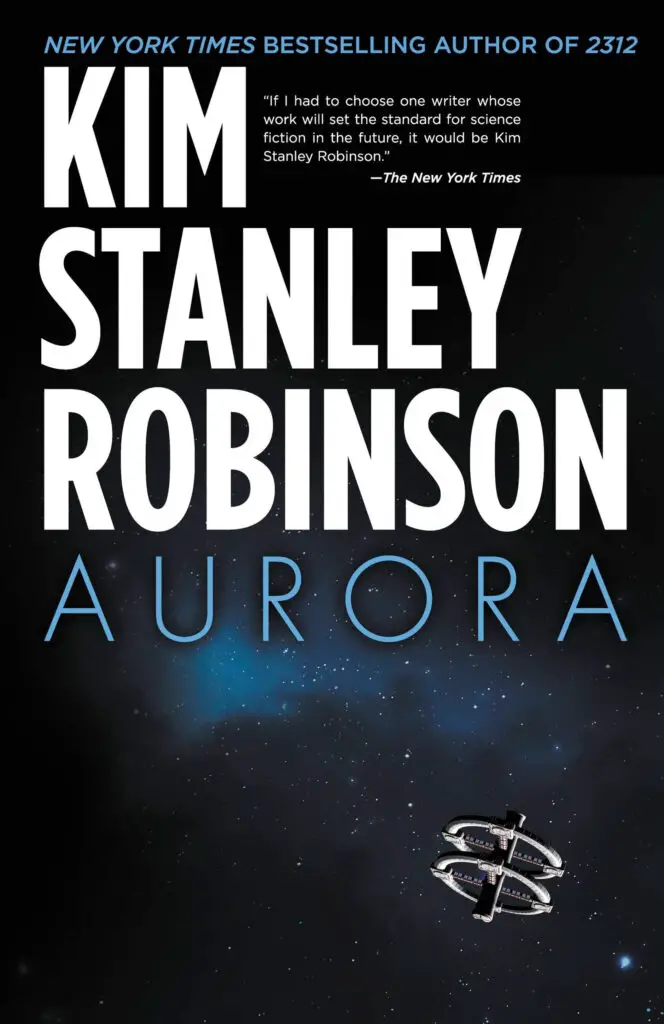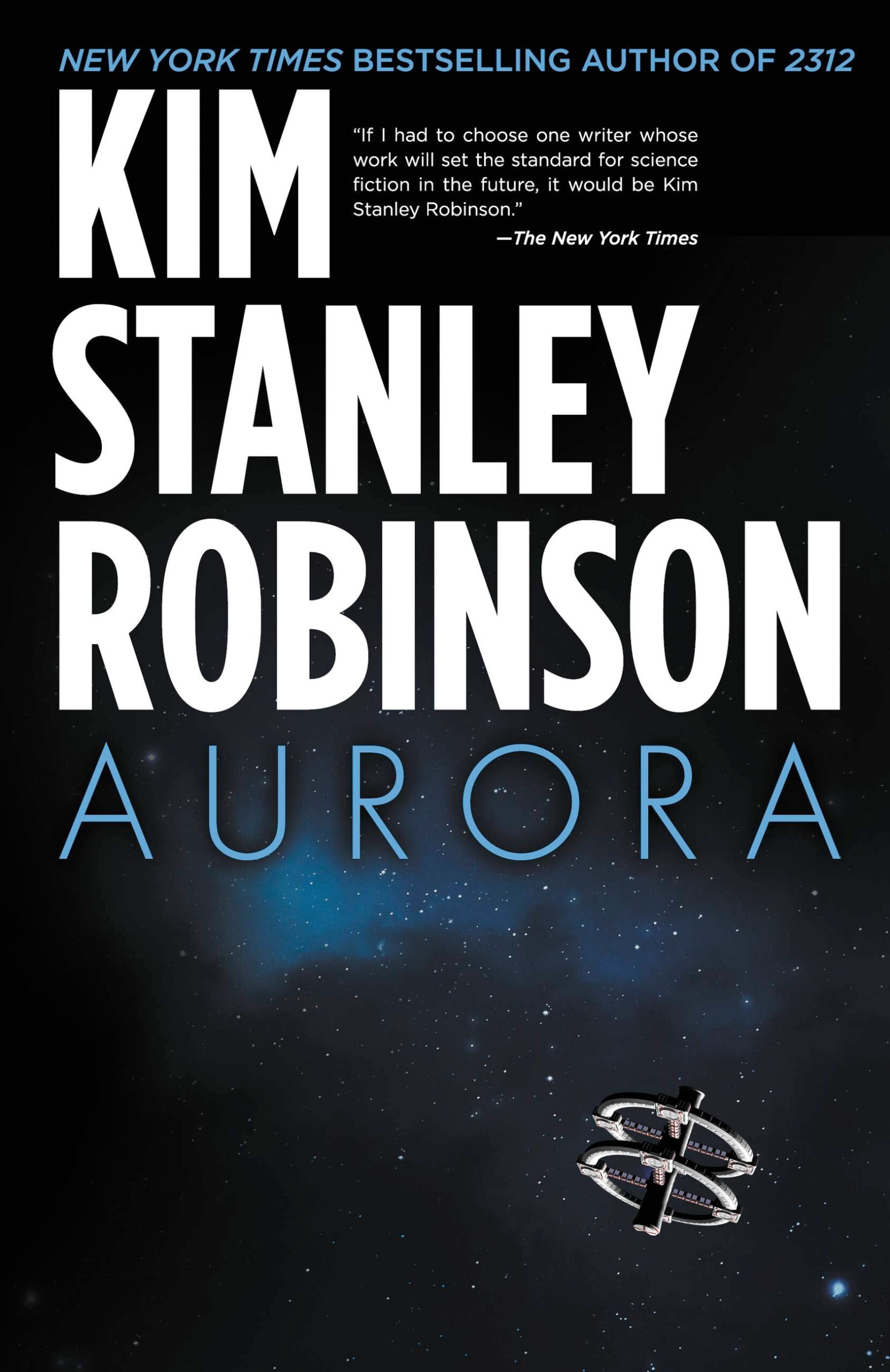Aurora by Kim Stanley Robinson

It’s hard to know how to write about Kim Stanley Robinson’s novel, Aurora, and do it justice.
On one hand, to read it meticulously means there are pages – and pages – of highly involved, dry, motionless prose that are cerebral and even mind numbing. On the other hand, that prose is absolutely warranted, in that the “narrator” in parts is an advanced network of software programs and hardware (i.e.: “the ship”) that has been tasked by the Chief Engineer to capture a narrative account of a generational voyage. This narrator by necessity struggles with organic concepts of language and expression. (“An unsolvable problem: sentences linear, reality synchronous. Both however are temporal. Take one thing at a time, one after the next. Devise a prioritizing algorithm, if possible.”) This is an imperative part of the story.
On one hand, the hard science of Kim Stanley Robinson’s writing may be off-putting for those who enjoy science fiction full of flash and flair. People like me. But on the other hand, to lessen the density of the knowledge imparted would trivialize the impact of that the science and therefore lessen the import of that knowledge, which would be an unforgiveable omission given the realistic bent of the story. This is an imperative part of the book.
On one hand, the characters in the novel tend to be somewhat remote and blunted. On the other hand, the scope of their story is so immense and so involved, that concentrating on deeper, more emotional attachments to individual players would lock the reader into spending too much attention on petty sub-plots and frivolous affectations, when the real grandeur is unfolding much larger scale, often at a distance. So instead we get characters that are painted in very precise brushstrokes that may seem unfathomable when viewed up close, but from a distance create an illuminating depth to a very small physical landscape. I think it can be understood how imperative…. oh, you get the point.
In effect, it all boils down to what one character cries out in exasperation: “It’s not me being negative… It’s the universe obeying its laws. Science isn’t magic! We aren’t fantasy creatures! We have been dealt a hand.”
And the hand that Mr. Robinson deals us is absolutely mesmerizing.
In the year 2545, a ship is launched from Earth towards the Tau Ceti system for the purpose of colonizing a moon circling the sixth of ten planets orbiting that star, a moon which is considered an Earth analog with .83 times the mass of Earth, an acceptable atmosphere, water, ice, rock and sand. A nearby planet in the system, while not ideal, could be used as a backup staging location in case of emergency. The voyage will take 170 years, give or take, so the ship has been equipped with regional biomes that mimic the Earth’s temporal zones, carrying not only materials to be used at the new habitation, but also those which can sustain the generations of humans, animals and plants that will live, be born, and die on the journey.
At its apex, it takes communications from the ship almost a dozen years to reach Earth, and another dozen for a reply to return. The travelers are, in effect, on their own. The moon – this new home – has been christened Aurora.
Freya is 14 years old on the 159th year of the journey. Her mother, Chief Engineer Devi, is a worrier; something is always going wrong on the ship. Devi feels the responsibility of keeping everything running keenly, but she fears the environmental factors that could not be accounted for, and the knowledge that is slowly being leeched away over time due to attrition.
Devi also has realized that in all the years that the ship has been traveling, there has never been a narrative captured of the voyage. So, while she herself struggles to relearn quantum computing, she tasks the ship with producing a narrative, using Freya as an organizational focus (“Sure. She’s as good as anyone, I guess.”). Using Freya as a hinge point, it is easier for the ship to give attention to what is happening now, rather than being bogged down in fact logging or back story.
Therefore we follow Freya, both from her own insight (having been born and living her entire life traveling through space, as did her mother before her, and her mother before that) and through the eyes of a ship attempting to narrate human behavior as the colonists reach their destination and encounter their potential new home, Aurora.
I will tell you that the colonists do land on Aurora. But as to what transpires, you will have to read for yourself. A hint, though – it won’t be what you expect, mainly because it’s honest. And all that hard science? It has set you up.
The universe obeys its laws. Science isn’t magic, and Freya and her fellow travelers are not even close to being fantasy creatures. We have been dealt a hand, and while it may feel restrained, it also feels real, and highly, incredibly satisfying. I found myself thinking about what transpired in this book long after reading the final page, and what stuck with me the most was not necessarily the places where the drama was the highest, or where the emotional pull the strongest, but the places where the story felt the most genuine. You’ll recognize them when you get there.
Oh, and those pages and pages of highly involved, dry, motionless prose that are cerebral and even mind numbing? Feel free to skim over them. You’ll get the gist of it. The rest will stay with you, and are definitely worth any amount of effort to get there. Read Aurora, and it will become clear why Kim Stanley Robinson has been touted by The Atlantic as “the gold-standard of realistic, and highly literary, science-fiction writing”. Not easy, no, but oh, so good.
—Sharon Browning

